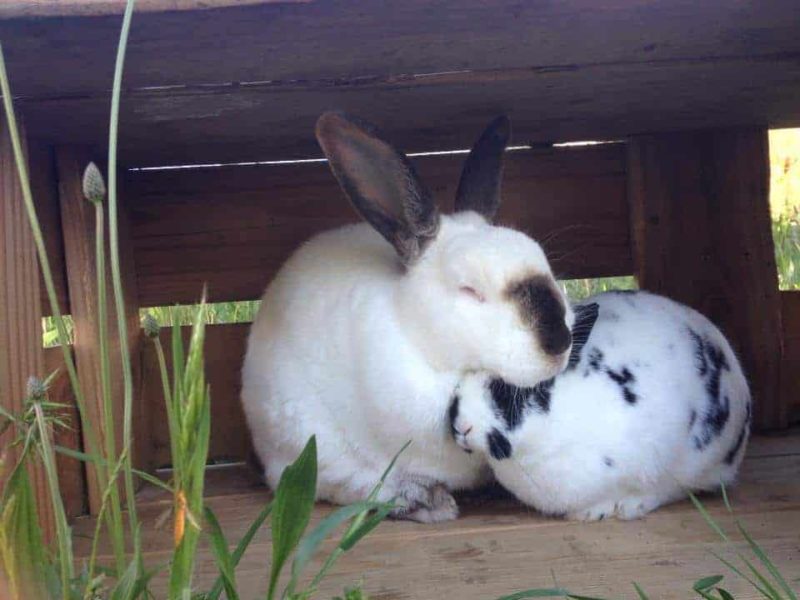
Before you provide sanctuary to a rabbitUnless explicitly mentioned, we are referring to domesticated rabbit breeds, not wild rabbits, who may have unique needs not covered by this resource. friend, it’s important to understand their species-specific needs that are likely quite different from other residents’ needs at your organization! This resource will cover some of the basics of providing care for rabbitsUnless explicitly mentioned, we are referring to domesticated rabbit breeds, not wild rabbits, who may have unique needs not covered by this resource. so you can ensure they are happy and healthy. Unlike many of the common resident species, many compassionate resources exist for their care, behavior, and lives. This is certainly a nice change of pace! We will be providing an introductory resource based on existing compassionate sources to provide sanctuaries with the basics of caring for rabbits in a sanctuary setting while introducing you to a couple of organizations where you can find additional compassionate and knowledgeable resources.
Rabbits As A Species
Rabbits are smaller mammals from the lagomorph family, alongside hares and picas, with around 30 species spread worldwide. While there are many wild rabbits, they have also been domesticatedAdapted over time (as by selective breeding) from a wild or natural state to life in close association with and to the benefit of humans (and, sadly, exploited). There are many different breeds of domesticated rabbits, from the Netherland Dwarf Rabbit, weighing as little as 1 pound, to the Flemish Giant, whose average weight is around 15 pounds, though some weigh in around 20! It isn’t only their size that varies, but their coloring, patterns, general temperaments, and, of course, individual personalities. Suffice it to say that their needs are a little different from those of your average sanctuary mammal resident! (Though there are some surprising similarities in their digestive system to horses!) Let’s burrow into rabbit living spaces!
Indoor Living Space Considerations For Rabbits
When providing appropriate living spaces for rabbit residents, there are several factors to consider to make a safe, comfortable home! Some indoor living spaceThe indoor or outdoor area where an animal resident lives, eats, and rests. factors include:
Flooring For Rabbit Living Spaces
Flooring is an important consideration for rabbit living spaces. Rabbit residents can fare well on a number of flooring types, but should never be kept on wire flooring. Concrete, tile, wood, or linoleum flooring (be sure there aren’t corners or damaged parts sticking out that rabbit residents might chew on and ingest) can be covered in cozy shavings, hay, or even towels or rugs, so long as the residents aren’t ingesting them. Dirt and grass are fine as well, as long as pesticides or fertilizers aren’t used. The key is to avoid slippery surfaces and potentially hazardous materials that they may chew on.
Litter Boxes For Rabbit Living Spaces
Most rabbit residents will use a dedicated space or a litter box to do their business. You can observe where residents prefer to urinate and then place a litter box with rabbit-safe litter in that space. Be sure not to use pine or cedar shavings in their litter area! Clean the litter box frequently, and check that they aren’t chewing on any element of it. Check out this resource at the House Rabbit Society for a list of rabbit-safe litters.
Nesting Materials For Rabbit Living Spaces
Materials such as hay and straw are good nesting options for rabbit residents. Rabbits tend to appreciate building nests as natural behavior, so effort should be made to provide them with various materials. You can even try out different types of nesting materials and see if residents have any preferences!
Ventilation For Rabbit Living Spaces
Proper ventilation is an important consideration when preparing a home for rabbits. Living spaces must be well ventilated (especially in extremely warm or humid environments), but never drafty.
Water Access In Rabbit Living Spaces
As with all other residents, fresh, clean water should always be provided. Ceramic water dishes are best. Automatic waters are acceptable but should be checked daily to ensure they are functioning properly. Rabbits also appear to consume more water when it is offered in a bowl versus automatic waterers. Be aware that rabbits will chew on exposed rubber, plastic, wiring, and other components, so steps must be taken to ensure inside and outside living spaces are free from chewing hazards, including in their drinking areas.
Always Check In On The Group!
It’s important to regularly observe rabbit resident group dynamics to be sure no one is being bullied and chased away from critical resources like shade, hiding places, food, water, and enrichment items. If you have a neighboring group of rabbits, it can be useful to use a shade cloth as a barrier between living spaces if you observe confrontationalBehaviors such as chasing, cornering, biting, kicking, problematic mounting, or otherwise engaging in consistent behavior that may cause mental or physical discomfort or injury to another individual, or using these behaviors to block an individual's access to resources such as food, water, shade, shelter, or other residents. behaviors between groups.
Outdoor Living Space Considerations For Rabbits
Rabbit Hemmoraghic Virus Disease
If you provide outdoor living spaces for rabbit residents, it is vital you become knowledgeable about RHVD and the possible threat to residents with outdoor access.
RHDV is highly contagious and often fatal. There are two strains, RHDV-1 and RHDV-2, with RHDV-2 spreading mostly in the western region and some midwestern regions of North America, in addition to areas of Mexico, Australia, and other countries.
Symptoms may include fever, difficulty breathing, a bloody nose, lethargy, a lack of appetite, seizures, jaundice, and sudden death. Some rabbits may be subclinical; they may carry the virus but not show symptoms. Those that survive can still shed the virus and be contagious for up to 2 months. This is a reportable disease. If you suspect a resident has RHDV, you must call your veterinarian immediately, both for palliative treatment options for your resident and so they can confirm the virus and notify the authorities of a potential outbreak in the area. The more humans caring for rabbits follow biosecurityMerck Veterinary Manual defines biosecurity as ”the implementation of measures that reduce the risk of the introduction and spread of disease agents [pathogens].” and vaccination protocols, the less likely it will spread. In fact, federal and state officials in North America say the spread is slowing due to awareness and the above measures. (As of July, 2023)
There are vaccinations for RHVD, but availability is limited. Speak to your veterinarian to learn more about access in your area, and if you are able, consider discussing whether it is appropriate to vaccinate residents against this disease.
Stay tuned for a resource covering RHVD and how sanctuaries can protect their rabbit residents.) In terms of outdoor spaces, it is important to prevent contact with wild rabbits.
While resident rabbits should never be left outside, nor should their only housing option be an outside living space, providing access to safe plants and dirt to dig in (and hidey holes to explore) can be very enriching for individuals. Residents should always be safely tucked away indoors at night.
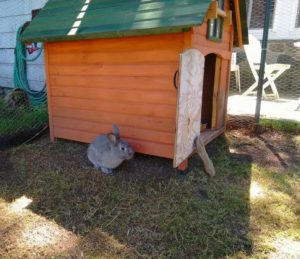
Keme enjoys the great outdoors on a nice spring day. Photo: Safe Haven Farm Sanctuary

Barney surveying his kingdom at Safe Haven Farm Sanctuary!
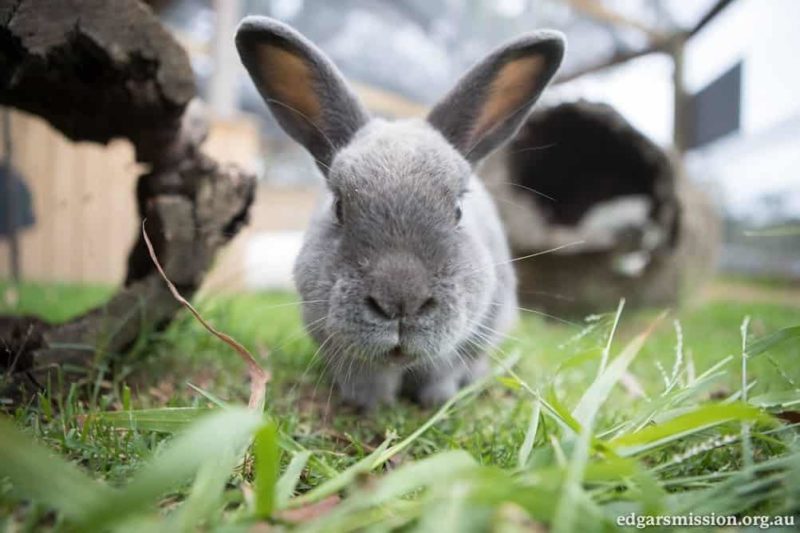
Max Bunny has an outdoor living area with hollow logs and more to explore at Edgar’s MissionThe stated goals and activities of an organization. An animal sanctuary’s mission is commonly focused on objectives such as animal rescue and public advocacy.!
So what factors are vital to consider when constructing a safe outdoor living space for rabbit residents? Let’s take a look.
Predator Safety For Rabbit Living Spaces
Rabbits are a prey species and are particularly vulnerable to predation from a number of species. Check out our Compassionate Wildlife Practices resource for predator-proofing living spaces. Proper fencing, netting or overhead coverage, spaces to hide, and access to indoor living space at night is vital for rabbit resident safety.
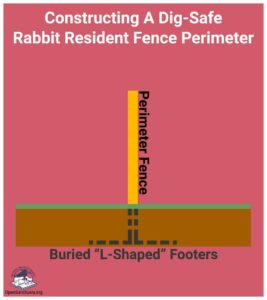
Honoring Rabbit Resident Digging Desires
Rabbits are diggers! Not only should you be concerned about someone trying to get in, but you must also remember it is a natural behavior for rabbit residents to dig, and you must ensure they cannot dig their way out of any living space. Burying an “L-shaped” footer around the outer perimeter fencing to prevent foxes and other wildlife from digging under the fence and burying an additional “L-shaped” footer on the inside of the living space can ensure residents don’t dig their way out.
Rabbits also need multiple spaces to hide and explore. There should be at least one hiding place for each resident, with an additional, larger hiding space for those who wish to snuggle up together.
Shade For Rabbit Living Spaces
Rabbits require shade. The source of the shade doesn’t matter as long as there is plenty for everyone! Rabbit-safe trees, shade cloths, or shelters are all acceptable forms of shade for rabbit residents.
Preventing Foreign Body Ingestion In Rabbit Living Spaces
Like all residents, rabbit residents are in danger of nibbling on objects that can cause illness or injury. They are excellent chewers and will gnaw on everything from electrical cords to baseboards and anything else that they fancy. They enjoy exploring things in their vicinity, and great care should be taken to clear living spaces of any potential hazards. For more information on foreign body ingestion, check out our resource here!
Caregiver Access To Rabbit Living Spaces
Care staff needs to be able to safely enter rabbit resident living spaces while ensuring residents remain safely inside. A living space inaccessible to caregivers or risks residents getting out is not an appropriate design!
Plants That Are Toxic To Rabbits
While there are a number of plants that rabbits can happily nibble on, there are others that can cause injury or illness. Outdoor living spaces should be inspected, and potentially hazardous plants should be removed. Check out the toxic plant database for plants that are toxic to rabbits.
Rabbit Living Space Temperature Considerations
Rabbits regulate their body temperature through their ears and do not tolerate high temperatures well. It is imperative that steps are taken to keep rabbits cool in warmer months. Temperatures as low as 77 degrees Fahrenheit (25 degrees Celsius) can cause heat stroke if rabbit residents are not provided with protection from the heat. Some ways to help rabbits beat the heat may include:
- Chilled or partially frozen water bottles for residents to lie next to
- Large ceramic tiles that have been briefly placed in the freezer can make a nice cool place for residents to rest and cool off
- Place ice cubes in a rabbit resident’s water bowl
- Purchase a cooling mat for rabbit resident living spaces
- Place a fan (with both the fan and its cords outside of the reach of any residents) blowing into the rabbit resident’s living space
- Limit outdoor times to cooler parts of the day
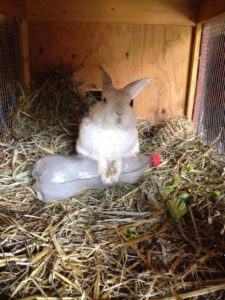
Sir Hoppy is demonstrating how to cool off in those warmer months with a nice frozen water bottle. Photo: Lewis Oliver Farm Sanctuary
Cold temperatures can be harmful as well, and steps should be taken to ensure residents are warm and snug during extremely cold temperatures. Rabbits in the wild would have a nice, dry burrow and would likely be snuggled up with other rabbits.
- Consider keeping rabbit residents indoors during cold spells. Rabbits do not handle extreme weather conditions well. Make their indoor living spaces warm, draft-free, and engaging.
- If the weather is just a bit chilly, consider letting residents into their outdoor space during the warmest part of the day. While rabbits are most active at dawn and dusk, they may value the option to go outdoors if it’s currently a limited resource.
- Provide extra hay and bedding, and make houses extra cozy for rabbit residents.
- Create a windbreak to protect rabbit residents from sudden drafts
- Offer fresh, warm water to rabbit residents
For more information on resident shelter temperature basics, check out our resource here!
Nutritional Needs For Rabbits
You might be surprised to learn that rabbits have a rather complicated digestive process. In fact, a rabbit’s digestive tract is physiologically more similar to that of a horse than a rodent or other small mammals! In the wild, rabbits eat many different types of grass, leafy plants, sprouts, and even some bark, twigs, and fruit or seeds from time to time. However, every individual rabbit is different, and a number of factors (including age, health concerns, weight, preference, and more) come into play when developing individual diets. You may find your veterinarian doesn’t want a certain resident on any pellets or that certain veggies are not a great choice for individuals with certain health conditions. Working with a qualified veterinarian to develop personalized diets for each rabbit resident in your care is important.
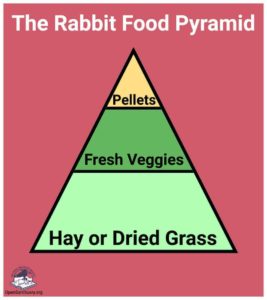
In general, resident rabbits should have a diet that consists primarily of hay or grass (around 80%), followed by appropriate vegetables, and a small, measured amount of pellets. (see our Daily Diet, Treats, And Supplements For Rabbits resource for more in-depth information on creating a healthy diet plan for rabbit residents.)
Potential Rabbit Health Challenges
As with any species, rabbits are susceptible to a variety of illnesses and diseases. Additionally, much like their wild counterparts, domesticated rabbits may show only subtle signs of illness or injury, as doing so in the wild would make them an easy target for predators. It is vital that care staff learn what is normal behavior for each resident and closely observe them for any subtle changes in behavior that might indicate a health issue. To learn more about potential rabbit health challenges, check out our resource.
Keep These Items On Hand!
If a rabbit stops eating, it could cause GI Stasis, a condition that can be fatal in rabbits. Time is of the essence, and having Critical Care, plastic syringes, and intubationthe introduction of a tube into a hollow organ (such as the esophagus or trachea) tubing could save a resident’s life. Critical Care is a nutritional powder that, once mixed with water, can be placed into a syringe and fed to the unwell rabbit. If they are unable to eat from a syringe, nasogastric intubation may be necessary. DO NOT attempt this if you have not been trained. Always call your veterinarian first if a resident stops eating, and be sure to become properly trained in how to syringe feed and safely intubate rabbit residents.
Performing Rabbit Health Checks
Ask An Expert
Before regularly conducting rabbit health checks, you should have a veterinarian or care expert give you hands-on training to be the best rabbit health advocate possible. Being trained to distinguish healthy conditions from abnormalities rapidly can be crucial in early health problem detection and effective treatment!
Before approaching a resident rabbit for a health check, observe them from a distance. Check their body condition, behaviors, movement, and general mood. Look around their living space for fresh droppings and urine, checking for normal, healthy stools. You can also examine any droppings for any sign of internal parasites and collect a sample for a fecal check.
Examine the rabbit’s body visually from top to bottom, looking for any signs of lesions, discharge, swelling, or parasites. For more information on what to look for in a health checkThe Open Sanctuary Project uses the term "health check" to describe health evaluations performed by caregivers who are not licensed veterinarians. While regular health checks are an important part of animal care, they are not meant to be a replacement for a physical exam performed by a licensed veterinarian., check out this great resource by Best Friends Animal Society.
Vital signs are also an important indicator of health. Ask your veterinarian how to properly take vital signs, including showing you how to take temperatures rectally and determine respiration and heart rate properly.
Appropriate Enrichment For Rabbits
This can be just as fun for care staff as rabbit residents! The best way to start any enrichment plan is first to consider a resident’s natural behaviors.
For example, in the wild, rabbits dig burrows, forage, and gather nesting material for their homes. Perhaps you would like to encourage your rabbit residents to interact with more of their living space in a way that supports their natural behaviors. Consider which behaviors you would specifically like to see increased or decreased. Based on that, in this example, it may be useful to consider adding a special dig area and offer lots of potential bedding materials that they can use to make their spaces comfortable. Treat balls, hidden treats, and rabbit-friendly plants hidden around their living space may also encourage them to forage.
The next step would be to observe their use of the proffered enrichment. Remember, it is only enrichment if the individual finds it enriching! If they are frightened by something or uninterested in it, then it isn’t enriching. Here is a list of enrichment possibilities for rabbit residents:
- Tunnels can be made with large PVC pipes cut into 3 ft lengths or the cardboard centers from carpet rolls. Be sure nothing has been coated with any substance that could be hazardous for residents!
- Cardboard boxes can be made into an edible castle or hidey-hole! Be sure always to have at least two entrances or exits, as this will help residents feel safer using them.
- Platforms are great for rabbits to climb up on and survey their surroundings. Including little platforms out of sturdy wooden boxes, large rocks, or solid shelving placed around their living space can help create a dynamic environment.
- Foraging is a great pastime for rabbit residents. There are many ways you can utilize nutritional enrichment. Hanging treat balls, hiding treats (veggies and fruits) around their enclosure, bringing in or growing rabbit-safe fresh grasses, or taking cardboard tubes, putting treats in them, and then closing off both ends gives rabbits fun foraging opportunities, too!
- Play toys can be fun for playful rabbit residents, as they can enjoy tossing things into the air and pushing things around their living space. Try giving them hard plastic balls (large enough they cannot chew or choke on them) for them to push around, or provide hard plastic baby toys like keys on a ring, and see what they do!
- Chew toys such as untreated wooden blocks, cardboard boxes, pine cones, strips of untreated pine, willow, apple branches, and wicker baskets can all be great safe chewing options for resident rabbits.
- Social time can be very enriching for many rabbits. In addition to rabbit socialization time, developing a bond with care staff can be enriching as well!
- Clicker-play can be a great way to communicate with residents and provide cognitive stimulation.
Social Needs Of Rabbits
Rabbits are very social, and only in unique cases should a resident rabbit be housed alone. As a rule, rabbits should always have companions. Isolation due to medical issues, or very rarely, individual preference due to personality conflicts, is the exception to this rule. If you plan to rescue a single rabbit, you should consider searching for another rabbit needing rescue. It is important to remember that although rabbits should live with others of their species, introductions can be challenging at first and should be handled with care. You will need to be sure to provide enough space and desirable resources so that residents are always ensured access to resources.
For more information, you can read this great resource about introducing rabbits to one another by the House Rabbit Society!
Safely Handling Rabbits
Before you need to handle your resident rabbits for medical care, start by simply spending time with them so they are comfortable with you. Let them check you out and choose to come to you. Slowly develop a relationship where they are comfortable being touched by you and being in your lap. If you do this, you may have an easier time performing a full health check when the time comes. Try a “less is more” approach when you need to move them from one place to another.
Never pick up a rabbit resident by their ears or their “scruff”- this is painful and stressful. Remember, rabbits are prey animals, and they typically find “looming” and being grabbed to be seriously upsetting, as this is how predators catch them.
It is also important to remember that rabbits have delicate spines, and improper handling can lead to serious injury if the resident becomes fearful and tries to twist away.
Nine Steps To Happy Rabbit Handling
- Develop a trusting relationship.
- Start low to the ground, on their level.
- Ideally, let them approach you.
- Put your arm gently and calmly at their side so they can see you.
- With that hand and arm, support their hindquarters and back.
- Pull them securely against your body, ensuring all four feet are also securely against your body.
- If you are interacting with a new, fearful rabbit resident and time is of the essence for safety reasons, prepare a travel kennel with a top that opens, make it cozy, and offer food. Slowly make the space they have smaller, and gently encourage them into the carrier. Stop and back up if they seem like they may panic.
- When placing them down onto a veterinarian’s exam table, lay a towel down so the surface is not slippery.
- If placing them back into their living space, try to get low to the ground and gently place them onto the ground.
DO NOT chase and corner a rabbit or try to scoop them up! This can cause unnecessary stress and injury as they may attempt to flee. The best tactic is to be patient and spend time with them daily, letting them approach you on ground level and building on that so that you will be ready when the time comes for health checks or veterinary visits.
While this resource doesn’t provide all the answers, hopefully, it helps give you an idea about the needs of rabbits in a sanctuary environment!
SOURCES:
What Should I Feed My Bunny? | Best Friends Animal Society
The Importance Of Hay | House Rabbit Society
Hay In Your Bunny’s Diet | House Rabbit Society
Common Rabbit Diseases | Vet West Animal Hospitals
Common Rabbit Diseases And Symptoms | FirstVet
Endo And Ectoparasites In Rabbits | The Veterinary Nurse
Rabbit Health Check: Signs Of A Healthy Bunny | Best Friends Animal Society








